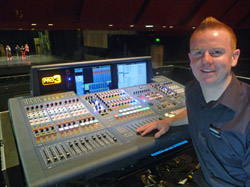The first Midas PRO3 live audio system to roll off the production line has been sold to the Rambert Dance Company as its touring console.
The PRO3 replaces the company’s Midas H1000, which was also the first in production.
The sale was made by LMC Audio’s sales manager JP Cavaco.
Rambert is well known for its use of live music and is the UK’s only contemporary dance company to tour with an orchestra, performing a vast range of contemporary and classical repertoire, some composed specifically for the company.
“The music side of the shows is now playing a larger role, so the whole sound infrastructure has got a lot bigger,” says Rambert’s front of house engineer Tomás O’Connor.
“Because of the wide range of repertoire, from orchestras to bands to electronic, we could have up to eight pieces in rep for a tour, then depending on the venue we perform any three of those pieces.”
“We have to be flexible enough to do them all, and retain continuity over the whole thing.”
O’Connor took the decision to buy a PRO3 along with sound designer David Tinson. “We realised we’d have to upgrade as the time available to set up a show now demands the flexibility of a digital desk, as shows become more complex,” he says.
“We’d both used lots of digital desks and were sceptical of sound quality, which seems to be the main compromise. However we thought the Midas XL8 and PRO6 were amazing, and when we heard the PRO3 was to become available there was no other choice.”
As well as offering Rambert the flexibility it needs, at a price to suit its budget, the PRO3’s sound quality is continuous with that provided by the H1000 for the past decade.
“Everyone at Rambert is used to a great sounding analogue desk, and the PRO3 sustains that continuity,” says O’Connor. “The show is also widely perceived to be acoustic, so we try to gently amplify it in a way that nobody realises it’s been amplified, while providing the sound energy they’re creating to every seat.”
In fact the PRO3 functions as the show’s system controller to zone, EQ and delay each venue, awarding every seat in the house the best possible sound. “We didn’t want to be converting the audio from analogue to digital and back again, and then passing it into another conversion process,” continues O’Connor.
“The A to D conversion that happens inside the PRO3 is so good, it seemed crazy to compromise that by passing it through another system controller. With the sort of PA that we tour, and the limited time to set up each show, it seemed right to use the PRO3 as our controller.”
O’Connor is finding the PRO3 frees up time before shows. “The previous analogue infrastructure, with loads of outboard, took so much time to set up that I didn’t have a lot of ‘sound’ time,” he says.
“We had to start from scratch every week. Now I’ve done a proper sound design for each piece, and everything is pretty much generic throughout the whole tour. It saves me so much time having to reload all the settings. I simply load the show file and go straight into it.”
“I save the show file from the previous week, then any tweaks I’ve done are carried over into the new venue.”
“I’ve also saved the graphic EQs and delay timings as presets so if we go to the same venue again and I’m doing a set of new pieces, I can take the presets from that venue, reload them and pretty much have my whole system set up.”
Finally, the footprint of the PRO3 – around half of the former system, with the only outboard rack sitting beneath the control surface – gives a healthy return in investment on seat sales alone.




















